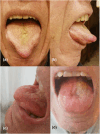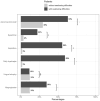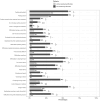Bulbar muscle impairment in patients with late onset Pompe disease: Insight from the French Pompe registry
- PMID: 39109844
- PMCID: PMC11414798
- DOI: 10.1111/ene.16428
Bulbar muscle impairment in patients with late onset Pompe disease: Insight from the French Pompe registry
Abstract
Background and purpose: Late onset Pompe disease (LOPD) is a rare neuromuscular disorder caused by a deficit in acid alpha-glucosidase. Macroglossia and swallowing disorders have already been reported, but no study has focused yet on its frequency and functional impact on patients' daily life.
Methods: We reviewed 100 adult LOPD patients followed in 17 hospitals in France included in the French national Pompe disease registry. The Swallowing Quality of Life Questionnaire and the Sydney Swallow Questionnaire were completed by patients, and a specialist carried out a medical examination focused on swallowing and assigned a Salassa score to each patient. Respiratory and motor functions were also recorded. Subgroup analysis compared patients with and without swallowing difficulties based on Salassa score.
Results: Thirty-two percent of patients presented with swallowing difficulties, often mild but sometimes severe enough to require percutaneous endoscopic gastrostomy (1%). Daily dysphagia was reported for 20% of our patients and aspirations for 18%; 9.5% were unable to eat away from home. Macroglossia was described in 18% of our patients, and 11% had lingual atrophy. Only 15% of patients presenting with swallowing disorders were followed by a speech therapist. Swallowing difficulties were significantly associated with macroglossia (p = 0.015), longer duration of illness (p = 0.032), and a lower body mass index (p = 0.047).
Conclusions: Swallowing difficulties in LOPD are common and have significant functional impact. Increased awareness by physicians of these symptoms with systematic examination of the tongue and questions about swallowing can lead to appropriate multidisciplinary care with a speech therapist and dietitian if needed.
Keywords: French Pompe registry; dysphagia; glycogenosis type II; late onset Pompe disease; macroglossia.
© 2024 The Author(s). European Journal of Neurology published by John Wiley & Sons Ltd on behalf of European Academy of Neurology.
Conflict of interest statement
C.L., M.S., P.C., A.B., A.M., and M.F. have received fees for participation on scientific boards and scientific congress sponsoring by Sanofi‐Genzyme. Fr.B., C.T., E.S.‐C., J.‐B.N., A.N.P., and S.A. have received fees for participation on scientific boards and scientific congress sponsoring by Sanofi‐Genzyme and Amicus Therapeutics. P.L. has received fees for participation on scientific boards by Amicus Therapeutics, Sanofi, Genzyme, and Spark Therapeutics, consulting fees from Sanofi Genzyme, BioMarin, Sanofi Genzyme, and Spark Therapeutics, and scientific congress sponsoring by Sanofi Genzyme, Amicus Therapeutics, and Spark Therapeutics. The other authors report no relevant disclosures.
Figures





References
-
- Laforêt P, Nicolino M, Eymard B, et al. Juvenile and adult‐onset acid maltase deficiency in France: genotype–phenotype correlation. Neurology. 2000;55:1122‐1128. - PubMed
-
- Dupé C, Lefeuvre C, Solé G, et al. Macroglossia: a potentially severe complication of late‐onset Pompe disease. Eur J Neurol. 2022;29:2121‐2128. - PubMed
-
- Hudgson P, Gardner‐Medwin D, Worsfold M, et al. Adult myopathy from glycogen storage disease due to acid maltase deficiency. Brain. 1968;91:435‐462. - PubMed
-
- Margolis ML, Howlett P, Goldberg R, Eftychiadis A, Levine S. Obstructive sleep apnea syndrome in acid maltase deficiency. Chest. 1994;105:947‐949. - PubMed
-
- Dubrovsky A, Corderi J, Lin M, Kishnani PS, Jones HN. Expanding the phenotype of late‐onset pompe disease: tongue weakness: a new clinical observation: lingual weakness in Pompe. Muscle Nerve. 2011;44:897‐901. - PubMed
MeSH terms
LinkOut - more resources
Full Text Sources
Medical

